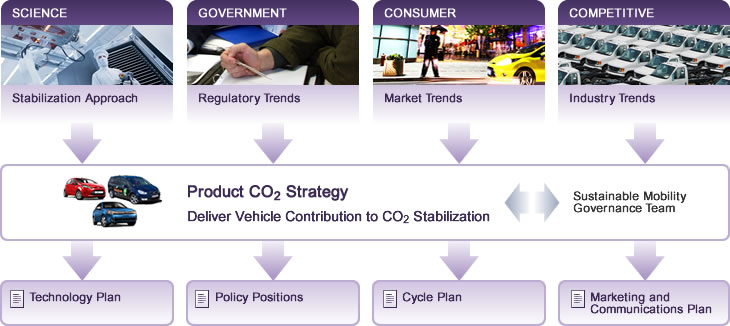-
MATERIAL ISSUES
- Materiality Analysis
-
Climate Change
- Climate Change: Related Commitments and Progress
- Greenhouse Gas Emissions Overview
- Climate Change Risks and Opportunities
- Our Strategy: Blueprint for Sustainability
- Ford's Sustainable Technologies and Alternative Fuels Plan
- Progress and Performance
- Climate Change Policy and Partnerships
- Electrification: A Closer Look
- Mobility
- Human Rights
- Vehicle Safety
- Sustaining Ford
- Perspectives on Sustainability
Toolbox
Our Strategy: Blueprint for Sustainability
To respond to the risks and opportunities posed by the climate change issue, our long-term strategy is to contribute to climate stabilization by:
- Continuously reducing the greenhouse gas emissions and energy usage of our operations.
- Developing the flexibility and capability to market more lower-GHG-emission products, in line with evolving market conditions.
- Working with industry partners, energy companies, consumer groups and policy makers to establish an effective and predictable market, policy and technological framework for reducing GHG emissions.
We have set a goal to reduce our U.S. and EU new-vehicle CO2 emissions by 30 percent by the year 2020, compared to a 2006 model year baseline. Our blueprint for sustainability, which spells out our technology and product strategy to meet this goal, is based on modeling of vehicle and fuel contributions to emission reductions and an analysis of market and regulatory trends (see figure below). The blueprint encompasses a series of commitments the Company has made, or participated in, to reduce the greenhouse gas emissions from our products and operations.
Product Sustainability Process

In addition, we have conducted dialogues with stakeholders, exploring sustainable mobility projects to demonstrate potential approaches to urban mobility that would integrate private and public transportation by multiple modes, enabled by information technology. Please see the Mobility section for more details.
The blueprint's product strategy – called the Sustainable Technologies and Alternative Fuels Plan – details the near-, mid- and long-term steps we are taking to develop and deploy vehicle and fuel technologies. The blueprint is supported by our sustainable mobility governance, which establishes structures and accountability for implementing the strategy.
We believe this strategy is already showing results by positioning our Company to take advantage of opportunities created by shifts in markets. Our commitment to outstanding fuel economy aligns well with consumer interest in fuel-sipping vehicles. During 2009, for example, our U.S. market share grew for the first time since 1995, driven in part by the popularity of several of our vehicles (including the Ford Fusion and Mercury Milan) that achieve best-in-class fuel economy.
For the longer term, we are preparing to provide regionally appropriate approaches based on global platforms to advanced vehicle technologies, including electric vehicles, biofuel vehicles and hydrogen fuel cell vehicles.